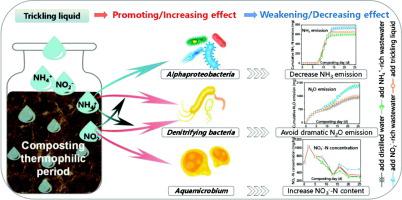Bioresource Technology ( IF 9.7 ) Pub Date : 2022-11-21 , DOI: 10.1016/j.biortech.2022.128362 Dong Xie 1 , Min Yang 2 , Shuang Zhang 2 , Mingyue Xu 2 , Jie Meng 2 , Chuanfu Wu 3 , Qunhui Wang 3 , Shu Liu 4

|
An NH4+–NO2–-rich wastewater discharged from a composting-biotrickling filter coupled system can be reused as a composting moisture adjustment agent. To investigate the impact mechanism of reuse, NH4+–NO2–-rich wastewater, NH4+-rich wastewater, NO2–-rich wastewater, and distilled water were added into the composting (i.e., AMN, AAN, ANO2, and ADW groups). Results show that compost of all groups met the corresponding criteria for stabilization, humification, and non-phytotoxicity of mature compost. AMN increased organic-N and NO3–-N content and reduced NH3 emissions, like AAN or ANO2, and avoid stimulating N2O emission in AAN and ANO2. Furthermore, LEfSe analysis of microorganisms revealed that AMN reduced NH3 emissions and increase organic-N content probably due to the inhibition of Alphaproteobacteria by ammonium, and increased nitrate content probably due to the stimulation of Aquamicrobium by nitrite. The avoided N2O emission is probably due to a negative synergistic effect on the stimulation from ammonia and nitrite to denitrifying bacteria (eg., Sphingobacteriaceae).
中文翻译:

就地利用生物滴滤池排放的富氮废水作为堆肥水分调节剂:对氮转化行为和微生物机制的洞察
堆肥-生物滴滤耦合系统排放的富含NH 4 + –NO 2 –的废水可作为堆肥调湿剂回用。为了研究再利用的影响机制,将富含 NH 4 + -NO 2 -的废水、富含 NH 4 +的废水、富含 NO 2 -的废水和蒸馏水添加到堆肥中(即 AMN、AAN、ANO2、和 ADW 组)。结果表明,所有组的堆肥均符合成熟堆肥的稳定性、腐殖化和无植物毒性的相应标准。AMN增加有机-N和NO 3 – -N含量,减少NH 3排放,如 AAN 或 ANO2,并避免刺激 AAN 和 ANO2 中的 N 2 O 排放。此外,微生物的 LEfSe 分析表明,AMN 减少了 NH 3排放并增加了有机氮含量,这可能是由于铵抑制了甲型变形菌,而增加硝酸盐含量可能是由于亚硝酸盐刺激了水生微生物。避免的 N 2 O 排放可能是由于对氨和亚硝酸盐对反硝化细菌(例如鞘氨醇科)的刺激产生的负协同效应。











































 京公网安备 11010802027423号
京公网安备 11010802027423号